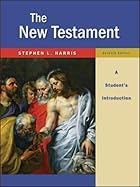
In my final text for Lesson 1 of: The New Testament (The Great Courses, Course Number 656), I read chapters 1-3 of The New Testament: A Student's Introduction, by Stephen L. Harris.
I found these notes from chapter 3 worth sharing, since I was unaware of the differences between these groups before reading this text:
Chapter 3: The Diverse World of Fist-Century Judaism
Sadducees: Priests that conservatively stuck to a literal reading of the Torah, eschewing the "oral traditions" of the Pharisees. The Sadducees were the ones who turned Jesus over to the Romans for execution. They were the ones who stood the most to lose if there was fighting between the Romans and the Jews because the Sadducees seem to have been the chief mediators between the Roman rulers and the Jews. They disappeared after the sacking of Jerusalem by the Romans in 70CE.
Pharisees: These priests were also conservative, but they also had an oral law, which was later recorded as Mishnah in 200CE. Although there seems to be a lot of dispute between Jesus and the Pharisees in the Bible, Jesus most likely got along fine with most Pharisees (as can be seen in some Biblical stories). The disputes between Jesus and the Pharisees may have been biased by problems between the early Christians and the Pharisees around the time the Gospels were written.
Samaritins: This is a group of people (named after their capital city Samaria) related to the Jews by religion, but whom the Jews in Judea regarded as alien. Instead of worshiping at the Temple at Mount Zion, the Samaritins worshiped at Mount Gerizim. The Samaritins recognized only the Mosaic Torah, and not the Prophets or other biblical writings.
Essenes: These are the people who are thought to have written the Dead Sea Scrolls somewhere between the mid-second century and late first century CE. Little is known about them, but their practices seem to have many similarities to later Christian practices, though Jesus is never mentioned outright. It is supposed by Harris that this is a non-Christian sect that anticipated some Christian rituals, rather than a group of early Christians. There also seem to be some parallels between the Book of Hebrews and Essenes' beliefs.
No comments:
Post a Comment
What do you think? I love getting comments!